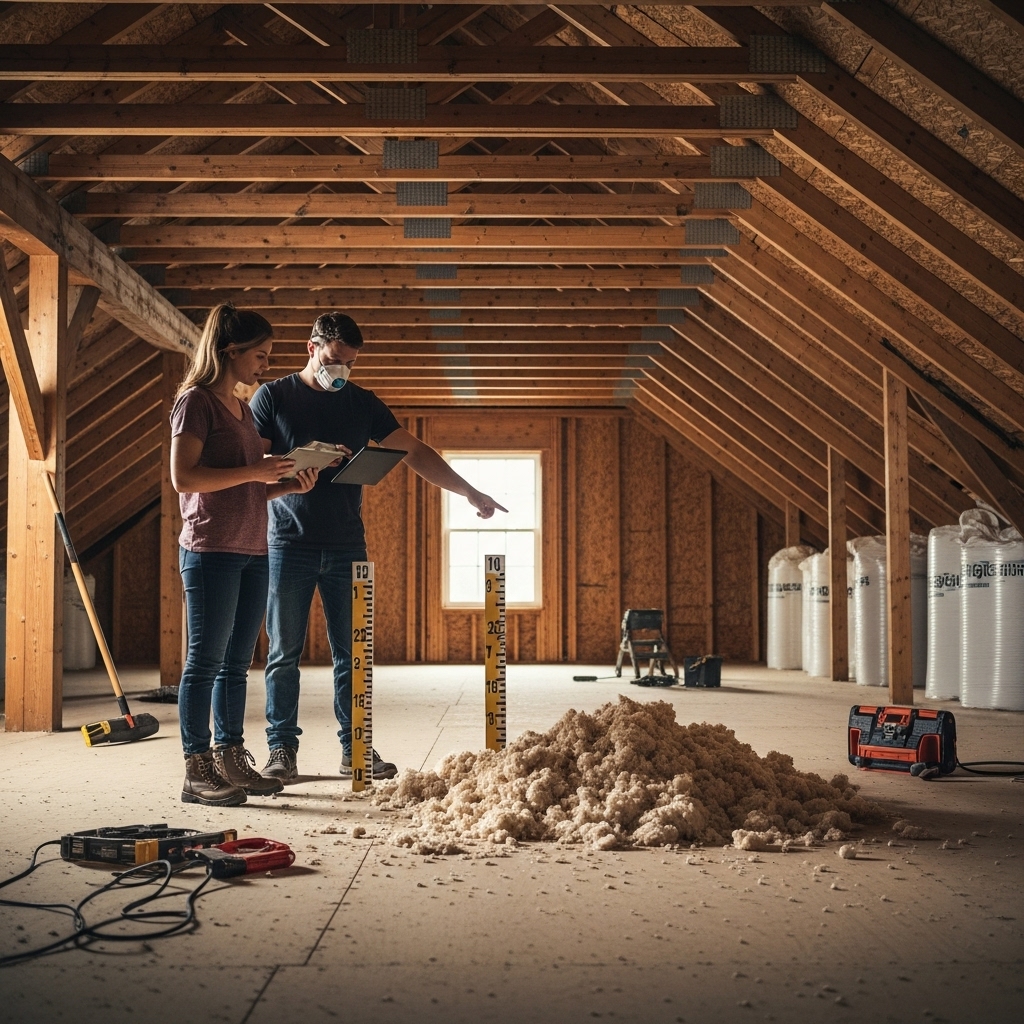When homeowners in Los Angeles ask about “attic insulation cost per square foot,” they usually want clarity and predictability. The idea of a simple, universal rate is appealing, but in everyday practice, the price you’re quoted reflects far more than the footprint of your house. It’s shaped by the age and layout of the attic, the material you choose, how much prep work is required, and the quality benchmarks that turn a quick job into a lasting improvement. Understanding those dynamics helps you compare proposals fairly and choose the approach that brings comfort, durability, and long-term performance. At the core, your decision is less about a single number and more about matching the right level of attic insulation to the realities of your home and the Los Angeles climate.
Los Angeles attics are as varied as our neighborhoods. A 1920s Craftsman may have tight, low-clearance spaces and a patchwork of old materials to manage. A mid-century ranch often presents wide spans interrupted by can lights and a few awkward corners. Newer construction might have deeper truss bays and better access but can still hide air leaks around top plates and chases. Each of these conditions impacts the effort required to prepare the attic and install insulation properly, and that is where per-square-foot concepts begin to blur.
What drives cost beyond square footage
The first and most important factor is preparation. Air sealing around plumbing penetrations, wiring holes, and top plates ensures that the insulation can perform at its rated level. Without sealing, your home loses energy through the same cracks and pathways regardless of how much insulation you add. Professional preparation also includes installing eave baffles to preserve ventilation and protect insulation from wind washing at the edges, as well as sealing and insulating the attic access. All of that groundwork is invisible once the job is done, but it is exactly what preserves your comfort day after day.
Material choice is another driver. Blown-in cellulose and blown-in fiberglass both deliver excellent thermal performance when installed to the proper depth and density. They differ in handling, coverage characteristics, acoustics, and certain fire- and pest-resistance properties. The right fit depends on your priorities: some homeowners value the acoustic qualities of cellulose, while others prefer the light, resilient structure of fiberglass. In either case, the quoted investment reflects the product’s specifications and the depth required to reach your target R-value.
Access plays a surprisingly large role. A tall, open attic is easier to work in than one with a shallow pitch and narrow pathways. The more time technicians spend maneuvering, setting up temporary work platforms, or carefully working around delicate finishes below, the more the project timeline and effort grow. Likewise, a cluttered attic used for storage requires thoughtful planning: creating raised platforms above the insulation line, protecting keepsakes from dust, and ensuring even coverage under and around stored items all add to the scope.
Existing conditions that shape the scope
Attic insulation rarely starts from a clean slate. Many Los Angeles homes have older batts that are misaligned or compressed, or a thin layer of loose-fill that has settled. If removal is recommended—for example, due to significant contamination or to correct a patchy base—the project will include containment, removal, and cleanup. Where existing materials are stable and clean, topping up with additional blown-in insulation is often the most efficient path to a higher R-value. Each of those scenarios shapes the proposal more meaningfully than raw square footage.
Penetrations and fixtures create another tier of complexity. Recessed lighting not rated for insulation contact may need special treatment or replacement. Bath fans that exhaust into the attic must be vented outdoors. Chimney chases, skylight wells, and mechanical platforms each require careful detailing to preserve safety and performance. These are vital tasks that don’t show up in a simple per-square-foot calculation, yet they determine how well your attic performs once the work is finished.
Ventilation deserves attention as part of the cost conversation. A well-vented attic allows insulation to perform consistently by moderating attic temperatures and controlling moisture. If your soffit vents are blocked by old materials or debris, or if a ridge vent is absent, the plan may include steps to restore airflow. That, too, folds into the real cost of a high-performing attic.
Why quality standards matter
Two proposals can quote the same square footage and the same R-value, yet deliver very different outcomes. What separates them is quality control: depth markers that ensure even coverage, air sealing verified before insulation goes in, baffles aligned with every soffit bay, and a neatly insulated, gasketed attic hatch. Homeowners sometimes feel these steps are extras, but in fact they are the framework that lets your insulation do its job. Good workmanship pays you back every day as your home holds temperature with fewer swings and your HVAC system cycles more gently.
In Los Angeles, we also think about noise, not just heat. Attics genuinely influence acoustics in bedrooms and living areas. A consistent insulation blanket softens street noise, footfalls from above, and even rain on the roof in rare storms. When you factor quality into your decision, consider both thermal and acoustic comfort—two sides of the same coin that make homes feel settled and serene.
Environmental considerations have matured, too. Many products now include recycled content or pathways to cleaner manufacturing. A thoughtful contractor will explain how those factors intersect with performance so that your choice aligns with your values without compromising results.
Translating a number into a plan
When you ask for “cost per square foot,” a reputable professional will likely pivot to questions: How accessible is your attic? What’s up there now? Are there comfort complaints tied to certain rooms or times of day? Do you have recessed lighting, or ducts in the attic? These aren’t deflections—they’re the real inputs that shape a sound proposal. Once your attic’s conditions are clear, a square-foot figure can be part of the conversation, but it will be anchored to specific tasks and quality checks.
It’s also important to align the R-value target with your microclimate. Coastal neighborhoods influenced by the marine layer might find a moderate level adequate, while inland valleys that endure hotter peaks typically benefit from a higher target. Roof color, shading, and ventilation all nudge that recommendation. The plan that emerges from this conversation feels tailored because it is—Los Angeles is a city of microclimates and varied architecture, and your attic should respect that.
Mid-project transparency helps homeowners feel confident. Seeing coverage charts, depth markers placed throughout the attic, and photos of air sealing before insulation goes in turns an abstract number into tangible quality. Along the way, the conversation often returns to the basics: adequate attic insulation, carefully executed, is a foundational element of comfort in Southern California homes.
Setting expectations for the work day
Most attic insulation projects unfold over a day or two, depending on preparation and access. A team will protect living spaces, set up containment at the attic hatch, and move systematically through air sealing, ventilation checks, and installation. If storage platforms are part of the plan, those are built to sit above the insulation line, preserving R-value while keeping access practical. Good crews leave the attic neat, with clear depth markers visible and the hatch insulated and sealed.
After installation, you should immediately notice a calmer interior. Rooms stay more even through afternoons, and evenings feel less prone to rapid cooling. The difference is most pronounced in rooms directly below the attic but benefits the whole home by easing the load on your heating and cooling system.
Frequently asked questions
Why do quotes that use cost per square foot still vary so much?
Because the number reflects more than area. Preparation, material type, access, ventilation corrections, and the condition of existing insulation all change the scope. Two attics with the same footprint can demand very different levels of effort and detail.
Is one material always the best value?
No. Blown-in cellulose and blown-in fiberglass both achieve excellent results in Los Angeles when installed correctly. The better value depends on your attic’s layout, acoustic goals, and how each product performs under your roof conditions.
Can I skip air sealing to save money?
Skipping air sealing undermines performance. Insulation slows heat flow, but air leaks can still carry conditioned air out and bring attic air in. Sealing first ensures the R-value you pay for delivers the comfort you expect.
What about my attic hatch—does it really matter?
Yes. An uninsulated or leaky hatch acts like a hole in your thermal blanket. A well-insulated, gasketed hatch maintains continuity, preventing a weak spot that can erase gains elsewhere.
Will I need to remove my old insulation?
Not always. If existing material is clean, dry, and reasonably even, topping up is often best. If it’s contaminated, badly installed, or causing ventilation issues, removal and a fresh start may be recommended.
How soon will I notice a difference?
Usually right away. The day after installation, most homeowners report more even temperatures, quieter rooms, and HVAC systems that feel less frantic. The improvement is both thermal and acoustic.
Ready for a clearer, more comfortable home
If you’re comparing proposals and want a plan that balances preparation, material, and performance, start with a thorough attic evaluation. A well-executed upgrade in attic insulation tailored to your Los Angeles home will bring immediate comfort and long-term stability. Reach out to a trusted local team to walk your attic, discuss priorities, and deliver a result you’ll feel every day.

